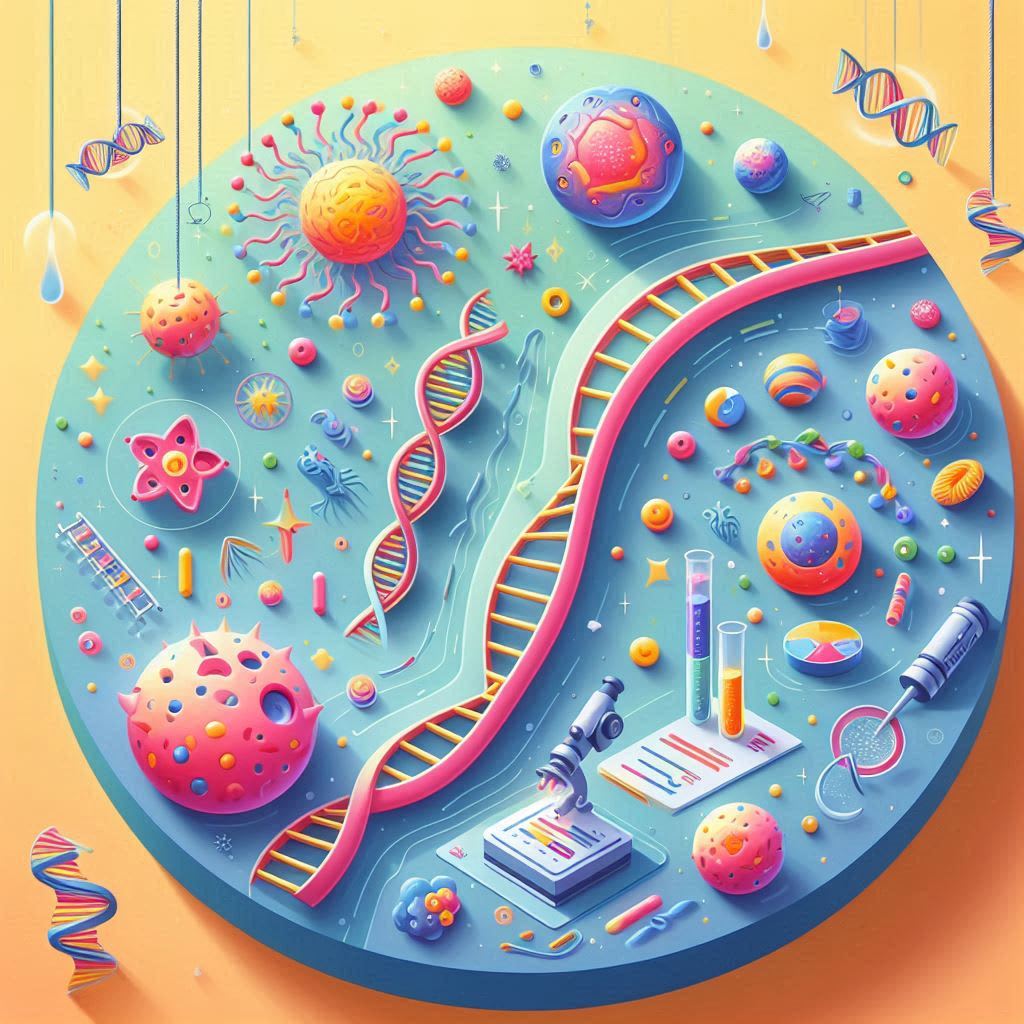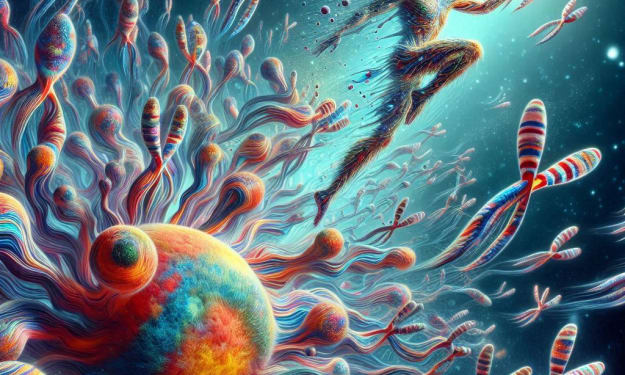From Blueprint to Action: Decoding the Magic of Transcription
The Power of Words: How DNA Transcription Turns Genes into Action

Imagine a symphony orchestra, with each instrument holding the potential for a unique melody. Our DNA is like the sheet music, encoding the instructions for building the complex proteins that orchestrate every function in our bodies. Transcription, the first act in this cellular play, is the process of converting this genetic code into a temporary message, ready to be translated into proteins. But how does this intricate dance unfold, and why is it so crucial for life as we know it?
The Central Dogma: From DNA to Protein
Before diving into the specifics of transcription, let's set the stage. Our genetic information resides within DNA, a double-stranded molecule shaped like a twisted ladder. Each rung of the ladder is made of complementary pairs of chemical bases: adenine (A) with thymine (T), and guanine (G) with cytosine (C). However, DNA is primarily confined to the nucleus, the control center of the cell. Proteins, on the other hand, are the workhorses that carry out countless tasks throughout the cell. So, how does the cell translate the instructions locked away in the nucleus into functional proteins in the cytoplasm?
This is where transcription comes in. It acts as the bridge between DNA and protein synthesis, a process known as the central dogma of molecular biology. During transcription, the information encoded in DNA is copied into a single-stranded molecule of messenger RNA (mRNA). mRNA then carries this genetic message out of the nucleus and into the cytoplasm, where it serves as the blueprint for protein assembly in a process called translation.
The Intricate Stages of Transcription:
Think of transcription as a three-act play, with each act playing a vital role in ensuring the accuracy and efficiency of the process:
Act I: Initiation - Setting the Stage
The play begins with RNA polymerase, the maestro of transcription, recognizing a specific region of DNA called the promoter. This promoter sequence acts like the "start" button, indicating where the mRNA needs to be synthesized. Additionally, other regulatory proteins called transcription factors bind near the promoter, fine-tuning the process and controlling which genes are transcribed at any given time. Once everything is in place, RNA polymerase unwinds a short section of the DNA double helix, exposing the single strands like open sheet music.
Act II: Elongation - The Melody Takes Shape
With the stage set, the real magic begins. RNA polymerase acts like a skilled musician, reading one strand of the DNA (the template strand) in a 3' to 5' direction. Using the complementary base pairing rule (A pairs with U in RNA, and G pairs with C), RNA polymerase incorporates ribonucleotides (the building blocks of RNA) to create the new mRNA molecule. This newly synthesized mRNA strand grows in a 5' to 3' direction, carrying a copy of the genetic code from the DNA.
Act III: Termination - The Final Note
The play reaches its climax when RNA polymerase encounters a specific termination sequence on the DNA template. This sequence signals the end of the mRNA molecule, and RNA polymerase detaches from the DNA. The newly formed mRNA transcript undergoes some final processing steps within the nucleus before embarking on its journey to the cytoplasm, ready to be translated into a protein.
Beyond the Basics: The Symphony of Life
While the core process of transcription remains the same, recent advancements have revealed a fascinating complexity within this cellular orchestra. Here are some key insights that paint a richer picture:
Regulation Reigns Supreme: Transcription is a tightly regulated process. Cells don't need to produce all proteins at all times. Epigenetic modifications, like DNA methylation, and the presence of specific regulatory proteins can fine-tune gene expression, ensuring only the necessary proteins are synthesized at the right time.
- Alternative Splicing: More Than One Melody from a Single Score: The human genome contains a surprising amount of non-coding DNA called introns. During a process called splicing, these introns are removed from the pre-mRNA transcript, and the remaining coding sequences (exons) are stitched together. Interestingly, some genes can undergo alternative splicing, generating different mRNA isoforms, and consequently, different protein products from the same DNA sequence. This process allows for greater cellular diversity and adaptability.
- Non-Coding RNAs: The Supporting Cast: While mRNA takes center stage, it's not alone in the drama. There's a whole orchestra of non-coding RNAs (ncRNAs) playing crucial supporting roles. These ncRNAs, like microRNAs (miRNAs) and long non-coding RNAs (lncRNAs), can regulate gene expression by binding to mRNA or interacting with DNA, further fine-tuning the symphony of protein production. Understanding the intricate workings of transcription holds immense potential
- Decoding Disease: When the Melody Goes Wrong, Mutations in genes can disrupt the process of transcription, leading to the production of faulty proteins or a complete lack of necessary proteins. This can have profound consequences and contribute to various diseases. For example:
- Cystic fibrosis: A genetic disease caused by mutations in the CFTR gene, which encodes a protein responsible for transporting chloride ions across cell membranes. Transcriptional defects can lead to the production of a non-functional protein, causing the hallmark symptoms of cystic fibrosis, such as thick mucus buildup in the lungs.
- Cancer: Uncontrolled cell growth, a hallmark of cancer, can be driven by mutations in genes that regulate transcription factors. These mutations can lead to the overproduction of proteins that promote cell proliferation or the suppression of proteins that normally act as tumor suppressors.
By studying the role of transcription in disease development, scientists are opening doors for novel therapeutic strategies. Here are some exciting possibilities on the horizon:
- Gene therapy: This approach aims to correct faulty genes or introduce healthy copies into cells. By targeting the DNA sequence responsible for a disease-causing protein, gene therapy has the potential to treat the root cause of the disease, not just the symptoms.
- Small molecule drugs: Scientists are designing drugs that can target specific molecules involved in the transcription process. For example, drugs that inhibit RNA polymerase activity could be used to treat certain cancers.
- RNA interference (RNAi): This powerful technique utilizes short, synthetic RNA molecules that can silence specific genes by targeting their mRNA transcripts. RNAi holds promise for treating a wide range of diseases, including genetic disorders, viral infections, and cancers.
The Future Symphony: A Deeper Understanding and New Horizons
The field of transcription is constantly evolving, fueled by breakthroughs in technology and our growing understanding of the genome. Here are some areas where exciting developments are taking place:
CRISPR-Cas9: This revolutionary gene editing tool allows scientists to precisely modify DNA sequences, offering possibilities for correcting genetic mutations that cause diseases at the DNA level.
Single-cell RNA sequencing: This technique allows researchers to analyze the transcriptome (the complete set of RNA molecules) of individual cells. This provides valuable insights into cellular heterogeneity and how gene expression varies across different cell types within an organism.
Personalized medicine: By analyzing an individual's unique genetic makeup and transcriptional profile, doctors can develop personalized treatment plans tailored to their specific needs. This holds promise for more effective therapies with fewer side effects.
The Final Notes: A Symphony of Knowledge
Understanding the process of transcription is like deciphering the intricate score of life. It allows us to appreciate the elegant dance between DNA and protein synthesis, the foundation for all biological functions. From unraveling the causes of disease to designing innovative therapeutic approaches, the knowledge gleaned from studying transcription is revolutionizing healthcare and shaping our future. As research continues to shed light on the complexities of this cellular process, we can expect even more exciting discoveries that will deepen our understanding of life itself.
About the Creator
suren arju
Hi there! I'm Suren, your startup guide. Entrepreneur, writer, dreamer - I share insights, tips & stories to fuel your startup journey. Ready to explore, learn & win together? Join me & let's redefine how we launch, learn & leap!
Enjoyed the story? Support the Creator.
Subscribe for free to receive all their stories in your feed. You could also pledge your support or give them a one-off tip, letting them know you appreciate their work.





Comments
There are no comments for this story
Be the first to respond and start the conversation.